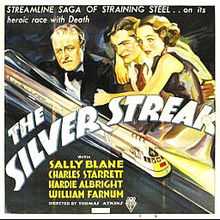The Silver Streak
| The Silver Streak | |
|---|---|
 Original film poster | |
| Directed by | Tommy Atkins |
| Produced by | Glendon Alvine |
| Written by |
H.W. Hanemann Jack O'Donnell Roger Whately |
| Starring |
Charles Starrett Sally Blane Hardie Albright William Farnum Irving Pichel Arthur Lake |
| Edited by | Fred Kundtson |
Release dates | November 30, 1934 |
| Country |
|
| Language | English |
The Silver Streak is a 1934 film loosely based on the record-setting "dawn-to-dusk" run of the Pioneer Zephyr on May 26, 1934.[1] The original Zephyr trainset was used for the exterior shots in the film, while interior scenes were filmed on a sound stage in Hollywood. For the film, the "Burlington Route" nameplate on the train's nose was replaced with one that read "Silver Streak".
One of the movie's promotional items was a small book called "The Story of the Silver Streak" which was illustrated with black and white stills from the movie.[2]
In 2006 Con-Cor International, Ltd. produced a model of the Pioneer Zephyr. A limited number (350 HO scale and 250 N scale) of these bore the nameplates of the Silver Streak from the motion picture instead of the standard Burlington Route nameplates.
Plot
In the face of seriously declining railroad passenger travel, engineer Tom Caldwell presents to the president of the CB&D Railroad,[3] B.J. Dexter, a design for a revolutionary diesel-electric train that will increase efficiency and lower costs. Dexter opposes change, however, and the railroad's conservative board of directors agrees with him, rejecting Tom's design. Tom quits in frustration. Sure that Tom's theory is sound, Dexter's daughter Ruth convinces Ed Tyler, a locomotive manufacturer, to look into Tom's design. Tyler is impressed with the concept and initiates immediate construction of a prototype. Soon Tom and his team prepare the Silver Streak for a well-publicized trial run with Dexter and Ruth aboard as passengers.
The Silver Streak fails to attain even half of its projected speed of 100 miles per hour (160 km/h), however, and is even easily overtaken by a steam-powered freight train. An angry Dexter tells Tyler that all the Silver Streak is good for is an exhibit at the Century of Progress Exposition to recover his advertising expenses. Tom is baffled by the failure since all the engine components worked perfectly during assembly but Dexter stubbornly insists that the concept will never work. Furious with Dexter's attitude, Tom quarrels with Ruth. Her brother Allen, who supported Tom's idea, tells his father that he is quitting the railroad to take a job as a civil engineer with the Six Companies, Inc. constructing the Boulder Dam.
Tom and Bronte, the engine's builder, discover that the electrical generator acquired for the Silver Streak has a manufacturing flaw. After correcting the flaw, the engine produces even greater power than he had earlier predicted. He tries to telephone Ruth with the good news to reconcile with her, but she has left Chicago to travel by train to California. Ruth discovers en route that infantile paralysis has broken out among the dam's construction crew and detours to the site only to find that Allen has contracted the disease. When a doctor informs her that Allen will die within 24 hours unless he receives treatment from an iron lung respirator, Ruth telephones her father to have the machine shipped to the dam by airplane. Dexter is told that the iron lung is too heavy for any transport airplane to carry and cannot be disassembled. Tom and Tyler persuade Dexter to take a gamble on the Silver Streak as Allen's only hope.
With less than twenty hours of time to travel 2,000 miles (3,200 km), the Silver Streak is given a cleared track and takes a shipment of Drinker Respirators out of Chicago. Tom includes Bronte on his crew, unaware that he is a foreign spy wanted for murder. As radio broadcasts track the progress of the "epic errand of mercy," the Silver Streak breaks records as it races south against time through the night. Nearing Boulder City, however, Bronte is revealed as a fugitive and sabotages the engine trying to stop the train, but instead causes it to speed out of control. Tom knocks the spy unconscious and regains control of the runaway train just before it arrives at the station.
Cast

- Sally Blane as Ruth Dexter
- Charles Starrett as Tom Caldwell
- William Farnum as B.J. Dexter
- Hardie Albright as Allen Dexter
- Irving Pichel as Bronte
- Arthur Lake as Crawford
- Theodore von Eltz as Ed Tyler
- Guinn "Big Boy" Williams as Higgins
- Edgar Kennedy as O'Brien
- Doris Dawson as Molly
Production
The Pioneer Zephyr was chosen for the film after the California-based Union Pacific Railroad declined to provide its high-speed passenger train, the M-10000. The plot element of the infantile paralysis epidemic took advantage of public fears of the disease rampant in 1934 when more than 1,000 cases were diagnosed in Los Angeles alone. Location filming of the Zephyr was done over a two-day period in September 1934 at the CB&Q yards in Galesburg, Illinois. The train was renamed The Silver Streak for the film, which had been a discarded choice of CB&Q president Ralph Budd, and the local high school adopted it as the nickname for its athletic teams.[4]
Reception
The film made a profit of $107,000.[5]
References
- ↑ F.S.N. (January 16, 1935). "The Silver Streak (1934) Burlington Zephyr Featured in 'Silver Streak' at the Mayfair -- 'White Cuckatoo' at the Astor.". The New York Times.
- ↑ Packer, Eleanor. "The Story of the Silver Streak." (1935, Whitman Publishing).
- ↑ The Chicago, Burlington and Quincy Railroad became the Chicago, Burlington and Denver in the film.
- ↑ Monson, Bill (2001). "The Silver Streak", The Zephyr Online.
- ↑ Richard Jewell & Vernon Harbin, The RKO Story. New Rochelle, New York: Arlington House, 1982. p78